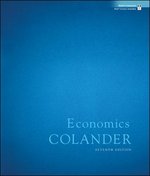Question
QUESTION 1: CASE STUDY Case Study on the Namibia Economic Outlook Macroeconomic performance and outlook Africa Development Bank, 2019 Real GDP, which peaked at 6.1%
QUESTION 1: CASE STUDY
Case Study on the Namibia Economic Outlook
Macroeconomic performance and outlook
Africa Development Bank, 2019
Real GDP, which peaked at 6.1% in 2015, contracted by an estimated 1.0% in 2019, following a 0.5% contraction in 2018. Aggregate demand fell sharply in 2016 and 2017 as the government began fiscal consolidation to correct growing imbalances from high public spending and falling revenues from the Southern African Customs Union (SACU).
The fiscal deficit narrowed from a peak of 9% of GDP in 2016 to 5.4% in 2018 and is projected to average around 5% over the medium term. It was financed through domestic and foreign borrowings that pushed public debt from 39% of GDP in 2015 to 46% in 2018. The pressure on the domestic debt market constrained liquidity, crowded out private sector credit, and dragged down domestic demand.
Monetary policy was accommodative to support growth under favourable inflation conditions. Estimated at 4.5% in 2019, inflation is projected to remain within the 3%-6% target in the medium term.
The current account deficit, estimated at 3% of GDP in 2019, started improving in 2017 as exports rebounded and import growth weakened due to subdued economic activity. At the same time, mining construction projects ended, and government capital spending was cut, sharply contracting construction and, through spill over effects on the rest of the economy, shedding jobs and reducing disposable incomes.
The inauguration of the Walvis Bay Container Terminal in August 2019 improved the port's efficiency and more than doubled its container handling capacity. Namibia has political stability, well-developed transport infrastructure, and abundant and diverse natural resources. Its potential as a regional transport and logistics hub and a participant in regional and global value chains benefits from a growing and dynamic regional market with well-developed transport corridors. Namibia's huge pool of institutional savings could finance high-return investments to contribute to rapid, inclusive, and sustainable growth.
Subdued economic conditions in South Africa could dampen, however, demand for exports and reduce SACU receipts. Weak growth in the Southern Africa region could also reduce transit cargo and the demand for transport services. Fiscal consolidation could be jeopardized if revenues underperform due to fragile economic recovery. Weak GDP growth, leading to further cuts in capital spending, could prompt another credit and economic outlook downgrade by rating agencies. Mining growth could be constrained by weak global diamond demand if trade tensions shrink global growth. Erratic rainfall, following a severe drought, could constrain agriculture production. The fiscal space to stimulate the economy is limited by uncertain SACU revenues. With subdued wage growth and weak labour markets, private consumption is unlikely to strengthen soon. Stagnating productivity, skill mismatches, and a weak business regulatory environment keep the economy from reaching its potential.
a)Outline the economic objectives of the Namibian government suggested in the case study and explain where in the case study they are suggested. [10 marks]
b)Discuss how the coronavirus pandemic is affecting the various aspects of the Namibian economy explained in the economic outlook. [20 marks]
c)Suggest the possible policies the government must take to counteract the effects of the coronavirus pandemic on the economy.[20 marks]
QUESTION 2
Discuss the usefulness of the concepts of elasticity such as price elasticity of demand, income elasticity of demand, advertising elasticity of demand and cross-price elasticity of demand to businesses in Namibia.[25 Marks]
QUESTION 3
Different economies use protectionist policies to protect domestic businesses from foreign competition. Discuss if it is worth it to protect domestically owned Namibian businesses from foreign competition.[25 marks]
Step by Step Solution
There are 3 Steps involved in it
Step: 1

Get Instant Access to Expert-Tailored Solutions
See step-by-step solutions with expert insights and AI powered tools for academic success
Step: 2

Step: 3

Ace Your Homework with AI
Get the answers you need in no time with our AI-driven, step-by-step assistance
Get Started


